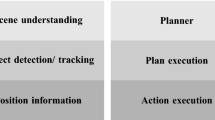Abstract
One of the most impressive feats in robotics was the 2005 victory by a driverless Volkswagen Touareg in the DARPA Grand Challenge. This paper discusses what can be learned about the nature of representation from the car’s successful attempt to navigate the world. We review the hardware and software that it uses to interact with its environment, and describe how these techniques enable it to represent the world. We discuss robosemantics, the meaning of computational structures in robots. We argue that the car constitutes a refutation of semantic arguments against the possibility of strong artificial intelligence.



Similar content being viewed by others
References
Bickhard, M. H., & Terveen, L. (1995). Foundational issues in artificial intelligence and cognitive science: Impasse and solution. Amsterdam: Elsevier.
Cummins, R. (1989). Meaning and mental representation. Cambridge, MA: MIT Press.
DARPA. (2005). Web archive of the October 2005 Grand Challenge. Retrieved June 16, 2006, from http://www.darpa.mil/grandchallenge05/index.html.
Dretske, F. I. (1995). Naturalizing the mind. Cambridge, MA: MIT Press.
Eliasmith, C. (2003). Moving beyond metaphors: Understanding the mind for what it is. Journal of Philosophy, 100, 493–520.
Eliasmith, C. (2005). Neurosemantics and categories. In H. Cohen & C. Lefebvre (Eds.), Handbook of categorization in cognitive science (pp. 1035–1054). Amsterdam: Elsevier.
Eliasmith, C., & Anderson, C. H. (2003). Neural engineering: Computation, representation and dynamics in neruobiological systems. Cambridge, MA: MIT Press.
Gopnik, A., Glymour, C., Sobel, D. M., Schultz, L. E., Kushur, T., & Danks, D. (2004). A theory of causal learning in children: Causal maps and Bayes nets. Psychological Review, 2004, 3–32.
Holyoak, K. J., & Thagard, P. (1995). Mental leaps: Analogy in creative thought. Cambridge, MA: MIT Press/Bradford Books.
Rehder, B., & Burnett, R. C. (2005). Feature inference and the causal structure of categories. Cognitive Psychology, 50, 264–314.
Russell, S., & Norvig, P. (2003). Artificial intelligence: A modern approach (2nd ed.). Upper Saddle River, NJ: Prentice Hall.
Searle, J. (1980). Minds, brains, and programs. Behavioral and Brain Sciences, 3, 417–424.
Searle, J. (1992). The rediscovery of the mind. Cambridge, MA: MIT Press.
Searle, J. (2004). Mind: A brief introduction. Oxford: Oxford University Press.
Shani, I. (2005). Computation and intentionality: A recipe for epistemic impasse. Minds and Machines, 15, 207–228.
Thrun, S., Burgard, W., & Fox, D. (2005). Probabilistic robotics. Cambridge, MA: MIT Press.
Thrun, S. et al. (2006). Stanley: The robot that won the DARPA Grand Challenge. Journal of Field Robotics, 23, 661–692.
Wired. (2006). The 50 best robots ever. Retrieved June 16, 2006, from http://www.wired.com/wired/archive/14.01/robots.html.
Acknowledgments
We are grateful to Chris Eliasmith and Abninder Litt for comments on an earlier version, and to the Natural Sciences and Engineering Research Council of Canada for funding. Thanks to Sebastian Thrun for information about Stanley, and to Paul Rybsky and Drew Bagnell for information about the 2007 Urban Challenge winner from Carnegie Mellon.
Author information
Authors and Affiliations
Corresponding author
Rights and permissions
About this article
Cite this article
Parisien, C., Thagard, P. Robosemantics: How Stanley the Volkswagen Represents the World. Minds & Machines 18, 169–178 (2008). https://doi.org/10.1007/s11023-008-9098-2
Received:
Accepted:
Published:
Issue Date:
DOI: https://doi.org/10.1007/s11023-008-9098-2




